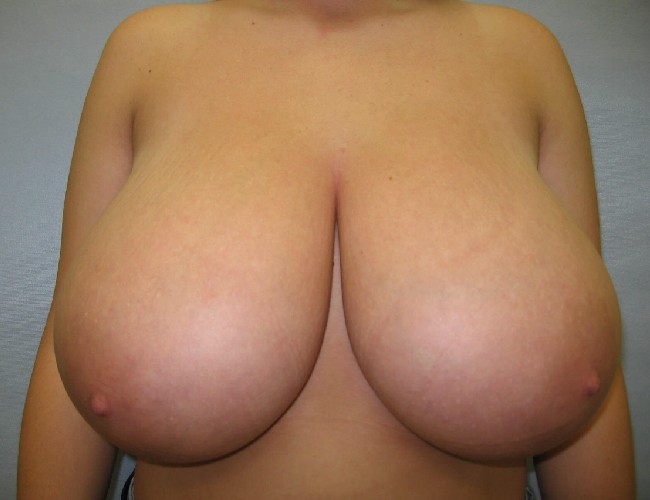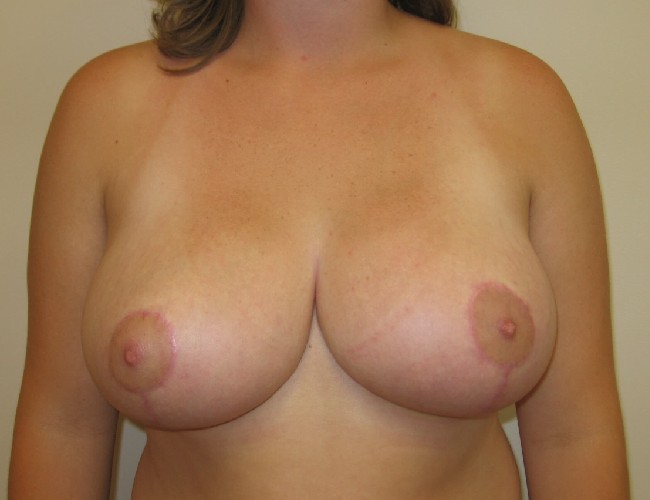Gigantomastia is a rare condition that causes excessive breast tissue growth, leading to physical pain, limited mobility, and emotional distress. If you are suffering from overly large breasts that impact your daily life, know that you are not alone – and there are solutions that can restore your comfort and confidence. The definition can be somewhat arbitrary. Many women believe their breasts are \”gigantic\” but may not be defined as gigantomastia. Some physicians believe removal of over 1500 grams of tissue per breast during reduction qualifies but it really is relative to your BMI. Dr. Lyle has removed over 2 lbs per breast on relatively normal weight or slender patients and they might be considered having gigantomastia.
Dr, Glenn Lyle, board-certified plastic surgeon in Raleigh, NC, has helped many women struggling with large breasts and feeling overwhelmed by their condition and unsure of their surgical options.
Please note that Dr. Lyle performs private practice breast reduction and does NOT accept insurance work. Insurance covers breast reduction in some cases but requires multiple steps including demonstrating conservative measures to alleviate back pain, neck pain and rashes. Most of these measures are ineffective. Weight loss is also required by many insurance companies although it doesn’t help the breasts get much smaller.
Understanding Gigantomastia
Gigantomastia is an uncommon yet serious condition that leads to extreme breast enlargement. It can develop suddenly or progress over time, often resulting in severe discomfort. While breast size varies widely among women, gigantomastia is distinguished by excessive, uncontrollable growth that affects physical health and quality of life.
Symptoms and Impact
Gigantomastia affects each woman differently, but common issues include:
- Chronic pain in the back, neck, and shoulders, often worsening over time. The additional weight places immense strain on the muscles and skeletal system, leading to posture problems and even spinal misalignment in some cases.
- Severe skin irritation and infections due to excessive moisture and friction under the breasts. This can cause painful rashes, fungal infections, and open sores that are difficult to treat without addressing the underlying breast enlargement.
- Difficulty with physical activity and exercise, making movement painful or restrictive. Many women with gigantomastia find it nearly impossible to engage in high-impact activities such as running or aerobics, limiting their ability to maintain an active lifestyle.
- Postural problems and spinal strain, sometimes leading to long-term musculoskeletal issues. Over time, this can contribute to chronic pain conditions, including nerve compression and herniated discs.
- Emotional distress, self-consciousness, and difficulty finding properly fitting clothing. Women with gigantomastia often struggle with self-esteem issues and frustration over limited clothing options, which can further impact their confidence and daily comfort.
For many patients, the physical burden of gigantomastia is just the beginning. The emotional toll can be just as challenging
Causes of Gigantomastia
While the exact causes of gigantomastia remain unclear, medical research points to several contributing factors. This condition can develop gradually or occur suddenly due to hormonal fluctuations, medical conditions, or certain medications.
Hormonal Influence
- Pregnancy-related gigantomastia – Hormonal surges can trigger excessive growth, sometimes leading to extreme enlargement within months. In some cases, breast growth may not subside after childbirth, leaving patients with disproportionately large and uncomfortable breasts.
- Pubertal or juvenile gigantomastia – Some adolescents experience rapid and disproportionate breast growth during puberty. This can be particularly distressing for young girls, leading to social anxiety and difficulty participating in sports or other activities.
- Medication-induced gigantomastia – A rare side effect of certain hormone therapies, including some fertility treatments, autoimmune medications, and drugs that affect estrogen and progesterone levels. These medications can cause excessive breast tissue growth as an unintended consequence.
Genetic and Health Factors
- Autoimmune conditions – although very rare-may contribute to abnormal breast tissue growth, particularly in cases of inflammatory disorders. Certain conditions may cause the body to overproduce breast tissue in response to chronic inflammation.
- Family history – suggests a possible genetic predisposition; women with relatives who have experienced gigantomastia may be more likely to develop the condition themselves. If multiple women in your family have had excessive breast growth, you may have a higher likelihood of experiencing similar issues.

Meet Dr. Glenn Lyle
Board Certified Plastic Surgeon
Dr. Glenn Lyle, a board-certified plastic surgeon, has been proudly serving the Raleigh, NC, community at Lyle Plastic Surgery and Aesthetics Center since 2002. With a deep passion for helping patients reclaim their confidence, Dr. Lyle specializes in transformative breast surgery and body contouring procedures. Whether addressing the effects of weight loss, pregnancy, or aging, his expert care and artistic approach empower individuals to look and feel their best. Dr. Lyle is dedicated to creating beautiful, natural results that reflect each patient’s personal journey and goals.
Diagnosing Gigantomastia
During your consultation with Dr. Lyle, he will conduct a thorough evaluation to determine whether you have gigantomastia and what treatment options may work best for you. This includes:
- Physical examination to assess the severity of the enlargement and its impact on mobility and comfort. I will evaluate the weight of the breasts, their proportion to your body frame, and any associated physical symptoms.
- Medical history review to understand potential hormonal, genetic, or medication-related causes. By identifying underlying factors, we can determine whether non-surgical treatments may be an option or if surgery is the best course of action.
- Imaging tests (Mammograms, Ultrasounds, or MRIs) to evaluate breast tissue composition and rule out underlying conditions such as tumors or cysts. These tests help confirm that the enlargement is due to gigantomastia rather than another medical issue.
Treatment Options for Gigantomastia
Many women suffering from gigantomastia attempt lifestyle adjustments, supportive garments, and physical therapy for relief. While these strategies can help in mild cases, surgical intervention is often necessary for significant and lasting improvement.
Non-Surgical Approaches
- Pain management with anti-inflammatory medications, physical therapy, or massage therapy. These can provide temporary relief but do not address the underlying issue of excessive breast size.
- Specialized support bras designed for extreme breast sizes to provide better comfort and posture support. Proper bra support can help distribute weight more evenly, reducing strain on the back and shoulders.
- Weight management in cases where weight fluctuations contribute to breast enlargement (though gigantomastia is not always linked to body weight). For some women, reducing overall body fat may slightly decrease breast volume, but for many, surgery remains the most effective solution.
Breast Reduction Surgery – A Life-Changing Solution
For most patients, breast reduction surgery (reduction mammaplasty) offers the best long-term relief from gigantomastia. During this procedure, I remove excess breast tissue, skin, and fat to create a smaller, more proportionate breast size. This surgery not only improves comfort but also enhances mobility, posture, and self-confidence.
What to Expect from Breast Reduction Surgery
- Comprehensive consultation to discuss expectations, surgical techniques, and desired outcomes. Every patient’s goals are different, and I take the time to develop a personalized surgical plan.
- Surgical procedure performed under general anesthesia, typically lasting 2-4 hours. The specific technique used depends on breast size, shape, and desired outcome.
- Customized incision techniques based on breast size, degree of reduction needed, and aesthetic goals. With severe macromastia- the Anchor pattern or Wise pattern is the most common technique utilized.
- Recovery period of about 4-6 weeks, with temporary swelling, soreness, and activity restrictions. Most patients can resume light activities within a few weeks, while full healing takes a couple of months.
Breast reduction surgery isn’t just about aesthetics-it’s about reclaiming your comfort, confidence, and quality of life.
Benefits of Breast Reduction Surgery
Many of my patients describe their breast reduction as life-changing. Some key benefits include:
- Immediate relief from chronic back, neck, and shoulder pain, often noticeable as soon as the patient wakes up from surgery.
- Greater ease in daily activities and exercise, allowing for a more active lifestyle and improved fitness levels.
- Better posture and spinal health, reducing long-term musculoskeletal strain and discomfort.
- Boost in self-confidence and emotional well-being, with many patients feeling more comfortable in their own skin.
- Improved ability to wear a variety of clothing styles, increasing wardrobe options and overall comfort.
FAQs About Gigantomastia
What are the early signs of gigantomastia?
The most common early sign is rapid, excessive breast growth that may feel out of proportion to the rest of your body. You may also experience discomfort, skin irritation, and difficulty finding properly fitting clothing.
Can gigantomastia occur in just one breast?
Yes, in some cases, gigantomastia can develop asymmetrically, where one breast grows significantly larger than the other.
Is gigantomastia a temporary condition?
It depends on the cause. In cases related to pregnancy or puberty, some women experience a reduction in breast size over time. However, in many cases, the condition persists, requiring medical or surgical intervention.
Can weight loss reduce the symptoms of gigantomastia?
While weight loss can help in some cases, gigantomastia is not always related to body weight. Some women experience significant breast enlargement despite having a low body fat percentage.
Does gigantomastia increase the risk of breast cancer?
Gigantomastia itself does not increase cancer risk, but it can make routine breast exams and mammograms more challenging due to excess tissue.
How do I know if I’m a candidate for breast reduction surgery?
If your breasts cause persistent physical discomfort, interfere with daily activities, or affect your emotional well-being, a consultation with a plastic surgeon can help determine if breast reduction is right for you.
What is the recovery process like after breast reduction surgery?
Most patients can return to light activities within a few weeks. Full recovery, including swelling reduction and scar maturation, can take several months.
Medical References
- Gestational Gigantomastia: A Systematic Review of Case Reports – PMC (NIH) – https://pmc.ncbi.nlm.nih.gov/articles/PMC5367223/
- Gigantomastia: Causes, Symptoms, Diagnosis & Treatment – Cleveland Clinic – https://my.clevelandclinic.org/health/diseases/23191-gigantomastia
- An idiopathic gigantomastia – PMC (NIH) – https://pmc.ncbi.nlm.nih.gov/articles/PMC4347046/
- Management of Gigantomastia: A Review of Two Cases – European Journal of Medical and Health Sciences – https://www.ej-med.org/index.php/ejmed/article/download/1351/853
- Bilateral Breast Hypertrophy (Gigantomastia) – International Journal of Advanced Research – https://www.journalijar.com/article/26073/bilateral-breast-hypertrophy-(gigantomastia/
- The “Pfizer Boob Job”: A Case of Unexplained Gigantomastia – PMC (NIH) – https://pmc.ncbi.nlm.nih.gov/articles/PMC11661758/
- Hyperplastic Breast Anomalies in the Female Adolescent Breast – PMC (NIH) – https://pmc.ncbi.nlm.nih.gov/articles/PMC3706054/
Schedule Your Consultation Today
Don’t let gigantomastia hold you back from living your best life. Schedule a consultation to explore your options and take the first step toward relief. Together, we can create a plan to restore your comfort, mobility, and confidence.
Further Reading
- Read Dr Glenn Lyle’s Image on Breast Reduction in North Carolina
- Read Dr Glenn Lyle’s Procedure on Breast Reduction in Raleigh, NC
- Read Dr Glenn Lyle’s Blog on What is Macromastia? Causes and Surgical Solutions
- Read Dr Glenn Lyle’s Blog on Causes and Solutions for Droopy Breasts
- Read Dr Glenn Lyle’s Blog on Teenage Breast Reduction
- Read Dr Glenn Lyle’s Blog on Do I Need a Breast Lift or a Breast Reduction?





